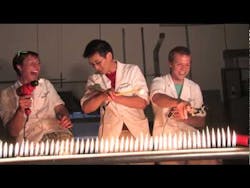Engineering Students Toy with Industrial Technologies
May 8, 2012
3 min read
A great deal of attention has been focused on engineering education over the past decade as it became apparent that fewer and fewer high school students were interested in pursuing engineering as a career. The resulting coverage of this issue left many with the impression that engineering schools in the U.S. had basically been hollowed out, leaving only the hardcore math geeks to bump around the halls and, maybe, occasionally into each other if enough of them happened to be present in the same place at a given moment.
But that’s not the reality. In the real world, engineering education is actually thriving and the students involved in it are not just dour-faced eggheads with little prospects for a career involving human interaction. In fact, they may be having a little too much fun with industrial strength technologies. And it just so happens that having fun with technology is exactly what some places are encouraging them to do.
At Waterloo Labs, an engineering outpost of sorts in Austin, Texas (and supported by National Instruments), students are teamed up with engineers from National Instruments (NI) to “show the world great and fun DIY projects that you can accomplish on a budget.”
A group of engineering students involved with Waterloo Labs has published some videos of their recent projects. Those students are: Dylan Caswell, EE major, University of Texas at San Antonio; Peter Gayler, EE/CE major, Lehigh University; Humphrey Huang, EE major, Columbia; and Tim Lynch, ME major, University of Rochester.
One of these projects is known as the Kinect-a-Sketch, which the team says will allow viewers to experience a natural user interface that will be fundamental in the future. The Waterloo Labs team used XBox Kinect, LabVIEW software, Arduino hardware, two stepper motors and an off-the-shelf Etch-a-Sketch to create an interactive drawing system. Kinect-a-Sketch makes it possible to control items on the screen using your body, thereby removing the need for a mouse. Check out the video below.
Another project they developed is known as “Karaoke on Fire,” which shows a visualization of the fundamental concept of sound waves in “a dangerously fun way.” The team used a Ruben’s Tube — which is a metal pipe with holes drilled along the top, a propane valve at one end and a speaker box at the other — to show sound waves in action. They used NI’s myDAQ hardware to input the sound from a microphone into LabVIEW ultimate system design software.
While the students may see this as a fun karaoke project, I think they should be approaching some major rock bands with the idea for their next stage set. Just sayin’ … See the video below.
Click here if you want to know more about Waterloo Labs.
About the Author
David Greenfield, editor in chief
Editor in Chief
David Greenfield joined Automation World in June 2011. Bringing a wealth of industry knowledge and media experience to his position, David’s contributions can be found in AW’s print and online editions and custom projects. Earlier in his career, David was Editorial Director of Design News at UBM Electronics, and prior to joining UBM, he was Editorial Director of Control Engineering at Reed Business Information, where he also worked on Manufacturing Business Technology as Publisher.
Sign up for our eNewsletters
Get the latest news and updates

Leaders relevant to this article:
